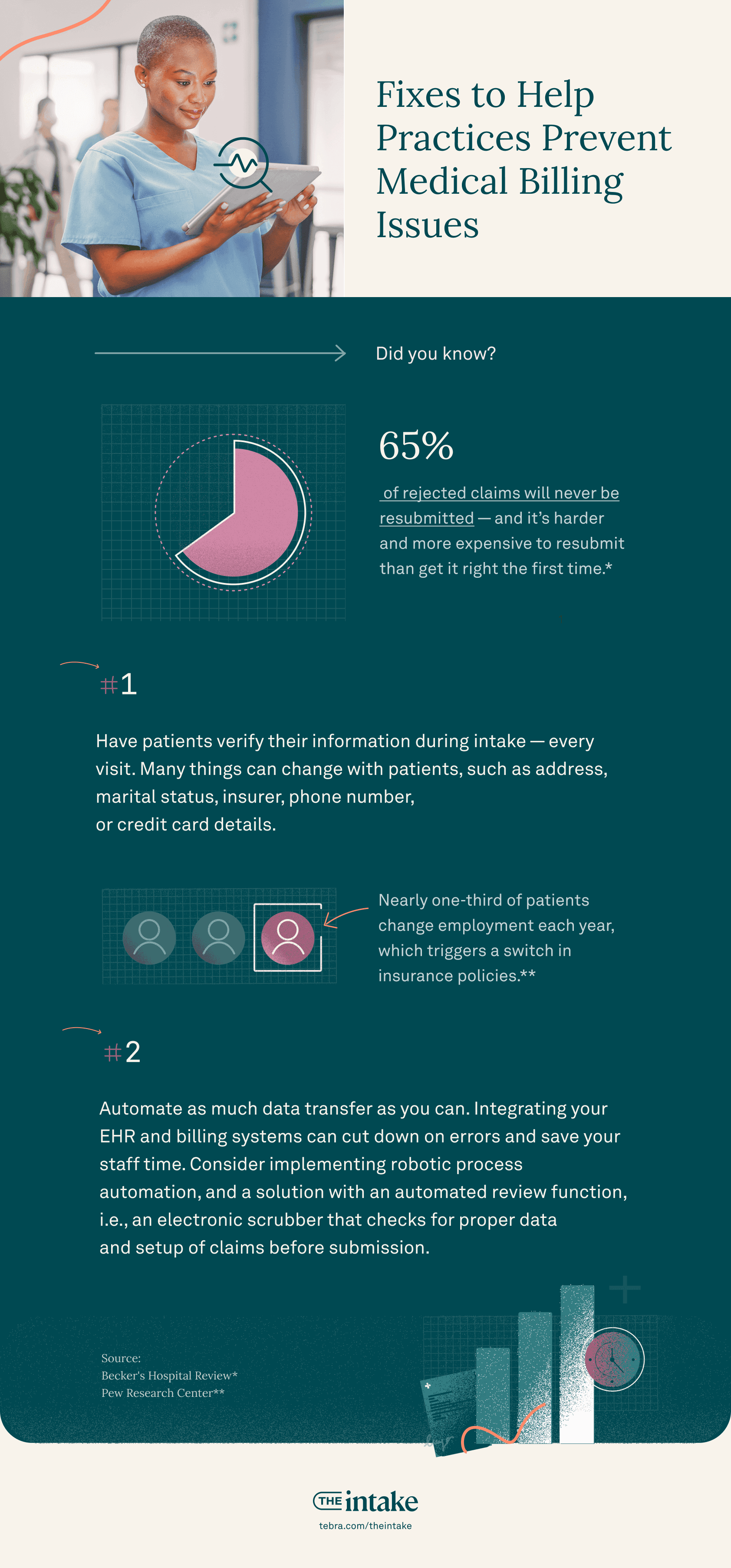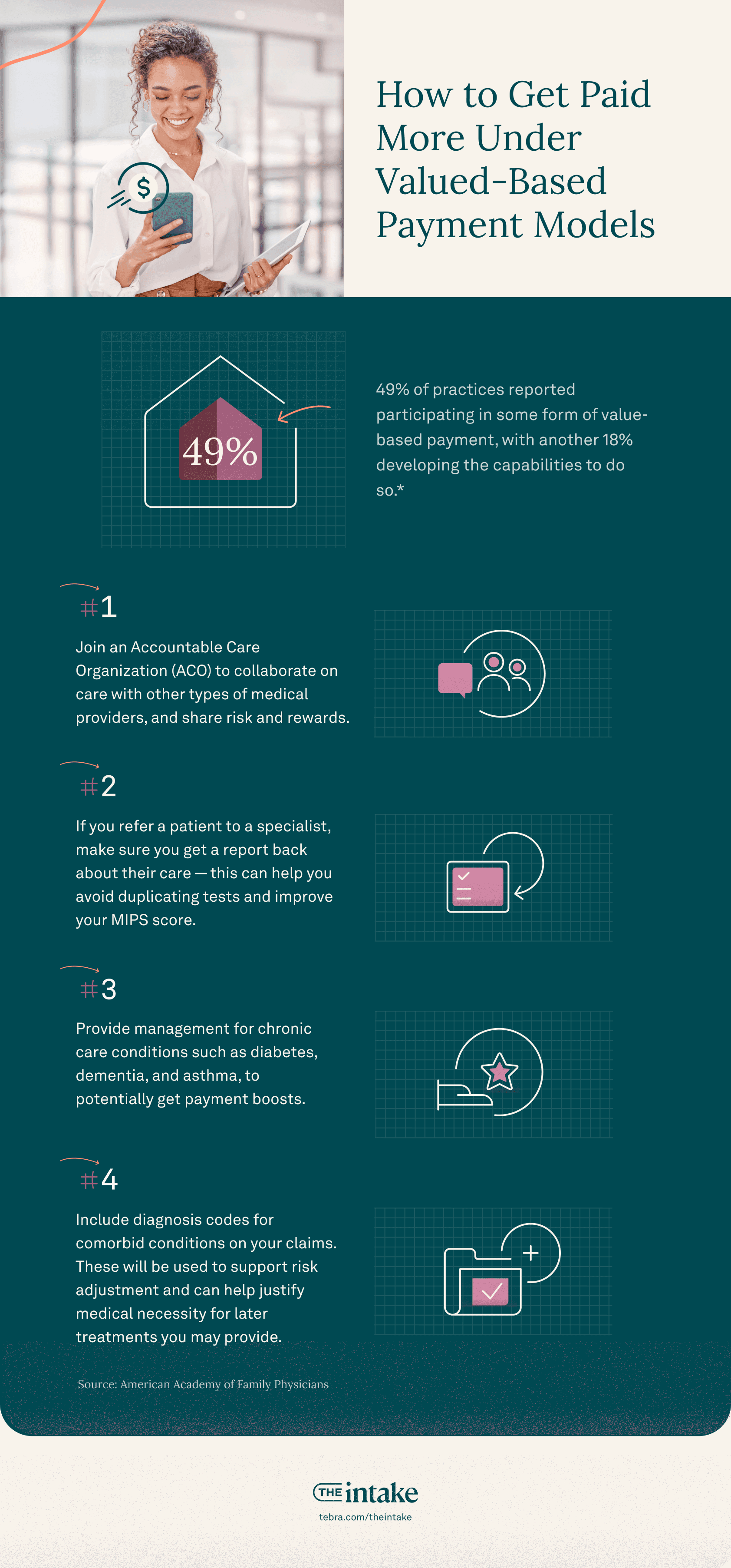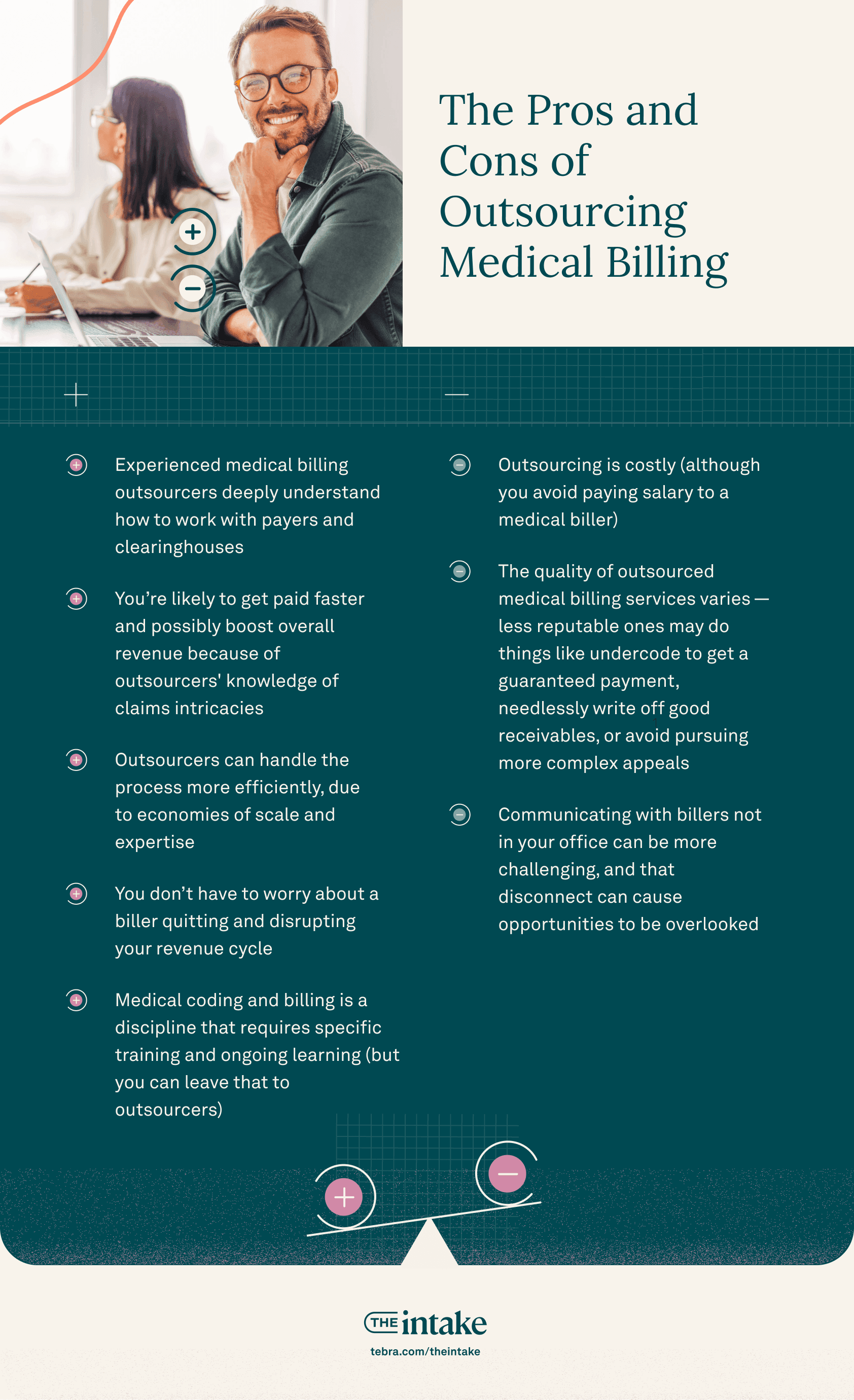Overview
- Navigating medical billing is fraught with challenges like complex insurance rules and frequent coding changes, but there are ways to optimize revenue and streamline operations.
- Automating data transfer can significantly reduce errors, and maintaining a clean claim rate of at least 95% is vital for operational efficiency.
- Transitioning to value-based reimbursement models offers financial stability and rewards quality care, but requires technological adaptations.
- Better revenue cycle management is part of improving profitability.
Many factors make the process of medical billing a special kind of hell for private practices: byzantine insurance rules, excessive documentation requirements, constant coding changes, and the barrage of government regulations.
These factors make it hard for practices to recover all the money they’re owed, and to do it in a timely manner. But by following best practices for medical billing, you can reach your profit potential.
This resource walks you through how to make the most of medical billing processes and procedures, whether you’re setting up a new practice or looking to improve your current situation.
In this article, you’ll find information to help you:
- Tackle common medical billing and insurance issues
- Save time on prior authorization and patient verification
- Get higher reimbursement rates under value-based care models
- Decide whether to insource or outsource billing
Beat medical billing and insurance issues and problems
The large quantity of data and complexity of rules for different insurers make billing problems inevitable.
A huge number of claim denials come down to administrative mistakes: either inconsistencies in patient identification or coding errors. And that’s a problem, because once a claim is rejected, it’s unlikely to get paid. A common industry estimate is that 65% of rejected claims will never be resubmitted — and it’s harder and more expensive to resubmit than get it right the first time.
There are 2 big fixes that can help practices prevent a huge number of medical billing issues:
- Have patients verify their information during intake — every visit. So many things can change with patients, such as address, marital status, insurer, phone number, or credit card details, that it makes sense to verify frequently. Perhaps the factor with the biggest impact on insurance verification: nearly one-third of patients change employment each year, which triggers a switch in insurance policies. Consider running weekly verification for patients who receive ongoing treatment such as therapy.
- Automate as much data transfer as you can. Manually moving data between patient records and billing systems isn’t just time-consuming and tedious — it introduces many errors. Integrated patient payments can cut down on these errors and save your staff time. Robotic process automation can assist with formatting data correctly for different insurance requirements around rules you set up. Integrate a solution with an automated review function, i.e., an electronic scrubber that checks for proper data and claims setup before submission.

Identify and fix the most common billing and coding errors
Coding errors are tough to avoid entirely, but the consequences are high. Mistakes lead to denials and rejections, which delay payment and create more work for your practice. But incorrect medical coding can also lead to charges of abuse — and even criminal and civil penalties when the payer is a government agency.
Or everyone’s favorite deterrent: an audit.
Common medical coding errors include:
- Lack of specificity — failing to use appropriate modifiers
- Unbundling — charging separately for items that should be bundled under one code
- Wrong patient ID
- Outdated codes
- Incomplete documentation — not including enough context about patient history, missing reports or summaries
- Failure to obtain referral or preauthorization — depending on insurers’ rules
Other consequences of errors in the medical billing cycle: a 2018 study showed errors cost physicians an average of 7% of total revenue.
Although it may seem counterintuitive, undercoding packs a punch as well, guaranteeing lost revenue. A recent AAPC Audit Services study of evaluation and management codes concluded 19% of the visit levels were undercoded.
Preauthorization tips to save time
The role of preauthorization in medical billing can’t be understated. It’s often required for payment, and it tells providers whether they will or won’t be reimbursed. But authorizing services can eat up a big chunk of time.
Luckily, there are ways to do it faster.
You can create a list of conditions that require prior authorization, assign this task to one knowledgeable staff member who keeps up with different payer rules.
Linking this to your billing system will help create a paper (er, digital) trail to support your claim.
Industry standards: What your clean claim rate should be
A clean claim rate is the ratio of accurate to inaccurate claims submitted on the first pass, and it’s an important indicator of whether your medical practice is billing efficiently. (To get your rate, divide your clean claims by all claims in any given period, e.g., January 2024).
The clean claim rate benchmark is 95% — meaning your claims should be error-free at least 95% of the time. A lower rate indicates systemic problems. Running a clean claim report can help you identify where the problems occur so you can best address them, whether it means adding some training for your medical billers or managing quirks on the payer side.
Sometimes a clean-claim report will also help you identify a pattern of one insurer incorrectly denying claims. For example, a federal watchdog found its Medicare Advantage contractors inappropriately denied compliant claims 18% of the time. Medicare rules can also change from week to week, and you might not get notified. Running regular clean-claim reports will help you spot costly issues early.
Denial management and resubmission tips
Rejection and denial management can make a big difference in revenue. Medical claims can either be denied because they’re incorrect or because the insurer doesn’t intend to pay.
The most efficient way to manage denials in medical billing is to run daily, weekly, or monthly rejection and denial management reports. You can gather missing information, correct data errors, and resubmit reports at the same time.
Appeal insurance decisions with insurance appeal letters
Insurance appeal letters are sometimes necessary when a claim is denied for medical necessity.
Your letter should include:
Patient and care information:
- The patient’s name
- Details of medical services provided
- Date of service
Denial information:
- Date of denial
- The claim itself (attached)
- Any details of follow-ups, such as a reference number of name of customer service person to whom you spoke
Argument:
- Why your provider thinks the service was medically necessary
- Cite facts from the insurers’ policies if possible
- Any supporting evidence, such as an article in a medical journal with indicated treatment
- If applicable, a letter supporting your treatment plan from the referring physician
Special guidelines for Medicare and Medicaid billing
While Medicare and Medicaid may pay lower rates, there are many advantages: lower rejection and denial rates, and more transparency about fees paid.
However, compliance is key for government contracts — the penalties are steep, including lower reimbursement rates or even a clawback of all fees paid. The government particularly looks for signs of fraud and abuse, like upcoding charges to receive higher reimbursements.
A major watchout in your Medicare billing responsibilities include determining whether Medicare is the primary payer or if there’s another insurer.
Documentation is a challenge, but some EHR systems can automate quality program requirements and help you monitor indicators, if you’re subject to reporting to the government (e.g., MIPS).
The easy fix in the medical billing process: Get patient information right
In our recent survey of medical billers, 92% wish practices did a better job at verifying that insurance information was up to date, and 54% wished they’d improve getting an accurate photo of the patient’s ID and insurance card.
Getting patient information right should be the easiest part of a claim, but it’s also tedious when performed manually.
Patient insurance verification
The patient verification process starts before the patient’s first visit. When patients schedule by phone, your staff can get their details then. Now, many practices receive online appointments from their website and/or requests from third-party appointment search sites — in that case, most specify that a scheduled appointment isn’t considered confirmed until the practice can talk to the patient to verify the appointment — and most importantly, their insurance.
The front line: Patient intake
Patient insurance verification typically starts on the phone but that’s often just the first stage of the journey.
Many practices verbally request the information over the phone, and continue the process the old-fashioned way, making copies of patient photo ID and insurance cards when a patient arrives at the office. Some prompt patients to complete these tasks themselves, either prior to the appointment via a second phone call, at their computer, or at a kiosk in the lobby.
Moving to electronic intake systems saves a lot of time and errors, but be sure to provide in-person support or another back-up plan for patients less able to navigate digital tasks.
Your front office team should also re-verify patient information every time a patient checks in — or set up an electronic system.
Reimbursements under the value-based care models
With spiraling healthcare costs and declining patient outcomes, the US government has a mandate to save money.
Value-based reimbursement models encourage medical providers to look at care more holistically to improve patient outcomes, which often means working as part of a team of care providers (such as coordinating a post-hospital discharge appointment) and using data-based treatment plans to reduce cost.
What is value-based reimbursement?
As part of a long-term strategy to reduce healthcare spending and improve patient outcomes, value-based programs seek to lower costs while improving patient outcomes. Many commercial insurers are following suit.
This requires a different set of skills but can be rewarding, both financially and in seeing patients thrive.
In a 2022 study by the American Academy of Family Physicians, 49% of practices reported participating in some form of value-based payment, with another 18% developing the capabilities to do so.
In theory, value-based reimbursement is supposed to benefit the payers and providers alike by reducing incentives to offer services not supported by data, drive health IT improvements, and focus more on preventative care.
While there are many execution challenges, there are some easier things you can do to get paid more under valued-based payment models:
- Join an accountable care organization (ACO) to collaborate on care with other types of medical providers, and share risk and rewards.
- If you refer a patient to a specialist, make sure you get a report back about their care — this can help you avoid duplicating tests and improve your MIPS score.
- Provide management for chronic care conditions such as diabetes, dementia, and asthma, to potentially get payment boosts.
- Include diagnosis codes for comorbid conditions on your claims. These will be used to support risk adjustment and can help justify medical necessity for later treatments you may provide.

Transition from fee-for-service to value-based reimbursement
Most value-based reimbursement now is actually based on fee-for-service with bonuses for quality, but that model can get more complex, with models such as bundled payments for services related to one condition, or working in an accountable care organization. Transitioning to true outcome-based services can be rewarding and stabilize revenue, but you need to implement technology and processes to handle the more complex requirements and documentation to prove you meet quality metrics.
However, many things providers do but don’t charge for, such as follow-up calls to patients, aren’t compensated in fee-for-service structures. Look for novel ways to communicate with patients — and payment opportunities may follow. Many insurers (including Medicare) pay for secure messaging with patients, for example.
Transitioning from fee-for-service to value-based reimbursement doesn’t need to happen overnight. The Value Institute for Health and Care recommends starting with a group of patients with similar needs (e.g., older people with multiple chronic conditions or people with migraines) and developing a holistic coordinated care program.
Streamline patient billing and payment processes
With the rise of high-deductible plans, independent practices have to focus more on collecting payments from patients — and it’s not always easy, especially when staff members are used to only requesting small co-pays. But digitization has made the patient billing and payment process easier for everyone.
Patient payments come in many forms: co-pays, coinsurance and deductibles, for those who are insured — and varying out-of-pocket payments for those who are not. According to MGMA, 47% of medical practices reported an increase in uninsured patients in 2022. It can be complicated to manage all of them without effective patient billing solutions.
Accelerating patient payments often comes down to two issues: timing and convenience. High-deductible plans mean patients are shouldering more of the burden — and many patients leave a medical office without paying.
As patients take on larger share of expenses — like high-deductible plans or self-pay — collections become more difficult. Fifty-six percent of practices reported days in accounts receivable have risen, indicating it takes longer to get paid.
Outstanding payments place a financial burden on practices and can strain the doctor-patient relationship. It means practices have to get more sophisticated in making it easy and convenient for patients to pay.
How to improve the patient payment process and overall experience
The patient payment experience has come a long way in recent years — and made it cheaper and easier for providers to get paid what they owe.
In our 2023 Patient Perspectives survey, 52% of patients told us they’d prefer to pay digitally. Patient payments can be collected in a number of ways, such as kiosks or texts with quick payment links. These not only please patients — they’re cheaper to manage and encourage faster payment.
On average, it takes an average of 3 paper statements for doctors to collect payments, but text reminders don’t require paper or postage, and they offer an easier way for patients to pay on the fly. Automating patient payments makes it more likely you’ll get paid quickly.
Text-to-pay links are especially convenient in the case of telehealth appointments or when the correct co-pay can’t be verified before a patient leaves your office.
Even if you still send paper patient statements, you can add QR codes to facilitate quick payments and links to further information. Many patients will prefer this to sending a check.
Download your free resource now
Access it instantly — just complete the form

Use online patient portals to improve the patient experience
Using your practice’s portal for online payment can make bills easier to understand and pay. Text-to-pay notices can link to your portal, and include not just a reminder to pay the balance but an explanation of charges. One big time-saver: patients can pay everything they owe at once.
Even more convenient for patients: online patient portals can store credit or debit card information so patients can pay in a click or two.
The key? Eliminate any friction, i.e., extra steps or confusion that slows down completing the payment. Use your employees to test your solution before offering it to patients.
If you choose to integrate online payment into your portal, remember:
- You must protect patient information to comply with HIPAA
- Includes end-to-end encryption to protect patient data
- Built-in fraud detection is important — you don’t want to get a fraudulent payment for a large charge
Some portals use a separate payment facilitator like Stripe to facilitate the charge with creditors, but you can find payment solutions with this feature built in.
Healthcare payment processing for subscriptions and payment plans
Healthcare payment processing isn’t always about one-off expenses. Some practices, including concierge medical services and many mental health and physical therapy providers, work on recurring payments. Many practices manage this by keeping credit card numbers in a spreadsheet — it’s difficult to comply with payment card industry regulations for protecting sensitive data this way. Charging payments and sending receipts can eat up a lot of time if done manually.
In addition, providers for expensive and elective services like cosmetic surgery may wish to offer payment plans as a patient benefit, especially if you can construct a routine draw patients can budget for.
Payment and subscription plans can be a hassle to manage but some billing software can help automate patient payment processing. Look for functionality that lets you send reminder texts with links to payment, and that automatically applies payments to the correct balance (for instance, toward the subscription or a one-off service for the same patient).
Improve profitability through revenue cycle management
Revenue cycle management in healthcare is a complex beast, but doing it well offers so many benefits for independent practices. Managing the revenue cycle isn’t just about achieving higher profits and faster payments — it brings visibility, consistency, and predictability into revenue flow.
And that’s important when you want to determine whether you have the resources to invest in new equipment and grow your practice.
What is revenue cycle management in the healthcare industry?
Revenue cycle management is organizing all the processes involved in the medical billing cycle — from verifying patient insurance to submitting bills and collecting payments — plus analyzing these processes to identify improvement opportunities.
The benefits of improving the revenue cycle management process
Why is revenue cycle management important? Improving it can help you:
- Maximize payments collected
- Accelerate revenue collection
- Find recurring problems
- Identify the most and least profitable parts of your business
- Forecast future revenue
Two of the best ways to improve healthcare revenue cycle management are:
- Create a billing playbook. Developing a guidebook with an improvement plan forces you to think through your processes clearly, and the document will serve as a guide for onboarding new employees or outsourcers.
- Illuminate opportunities. Even if you outsource billing — in fact, especially if you outsource billing — having a dashboard with key metrics can help you see exactly what’s going on with your practice so you can intervene if something is amiss.
What revenue cycle management reporting can tell you about your practice's health status
Revenue cycle reporting can help you identify issues with:
- Consistent under-payment by one of your insurers
- Low-profit services that you may wish to drop or modify
- Cash-flow problems on your horizon
Unlock the key revenue cycle metrics that can lead to practice growth
Top revenue cycle management metrics and KPIs you should track include:
- Days in receivables outstanding
- Receivables outstanding over 120 days
- Net collection rate
Find out how to calculate those revenue cycle KPIs and compare them to industry benchmarks.
Other important revenue cycle metrics for independent practices are the percentage of receivables over 120 days, net collection rate, and clean claims/claim denial rate.
Medical billing and coding outsourcing vs. in-house billing
Medical billing and coding is a time-consuming and costly task for medical, dental, and other healthcare practices. For many practices, whether or not to outsource billing services is a big question — and it might be one you ask again at different stages of growth.
Turning over your billing to an outsourced medical billing services vendor shouldn’t be a decision you take lightly. Billing affects your time, profit, and even your patient relationships — patients who forget to pay bills may dread or delay returning to your office.
The pros and cons of outsourcing the medical billing process
Pros:
- Experienced medical billing outsourcers deeply understand how to work with payers and clearinghouses, and they can avoid many claims problems
- With a quality outsourcer, you are likely to get paid faster and possibly boost your overall revenue because of their knowledge of the intricacies of claims
- Outsourcers can handle the process more efficiently, due to economies of scale and expertise
- You don’t have to worry about a biller quitting and disrupting your revenue cycle — or potentially separate employment with an under-performing employee
- Medical coding and billing is complex and changes frequently — making it a discipline of that requires specific training and ongoing learning (but you don’t have to worry about it)
Cons:
- Outsourcing is costly (although you avoid paying salary to a medical biller)
- The quality of outsourced medical billing services varies — less reputable ones may do things like undercode to get a guaranteed payment, needlessly write off good receivables, or avoid pursuing more complex appeals
- Communicating with billers not in your office can be more challenging, and that disconnect can cause opportunities to be overlooked

When to hire an external medical biller
There are some key inflection points when you should consider outsourcing your medical billing:
- Your practice is growing quickly
- You’re adding a new location — and can’t find help
- Losing your biller would cause serious disruption to your revenue
- Hiring and training a new biller would disrupt your practice
- Key metrics like clean claim rate and days in A/R resist improvement
The cost of outsourcing medical billing
Most medical billing outsourcing companies charge a percentage of collections — and this number should be under 8%, and it should decrease as your billing amounts increase. In our 2023 survey of medical billers, nearly half say they charge a percentage of collections between 5% and 7%. Only 7% of billers reported charging fees higher than 7%, but this number can vary by speciality.
In the same survey, while 17% say they don’t charge for patient collections, most do — typically around the same rate they charge for insurance collections.
Additional fees for start-up, termination, and data conversion may drive up the cost of outsourcing medical billing. Many medical billing outsourcers also offer ad hoc services like credentialing and contract negotiations at an additional expense.
The most efficient outsourcers perform most processes electronically, such as insurance eligibility verification and remittances, and offer credit card processing and online bill pay.
Get more out of your medical billing company
A medical billing company can do more than just handle billing for you. The best ones can drive key goals to help your practice, such as:
- Reduce the days spend in accounts receivable
- Improve your MIPS score
- Help you improve data capture for quality-based payment programs
- Forecast revenue
- Assist with credentialing or negotiating higher rates with insurers
Consider using a medical billing outsourcer that specializes in your industry — their expertise will be invaluable in helping you navigate the complex reimbursement landscape.
Workbook: Everything you need to beat common billing challenges
Optimizing the medical billing process is a huge win for any medical practice — it’s how you reduce the inefficiency and frustrations in the process to get paid more and faster. We’ve created a free resource to guide your journey. This comprehensive guide provides practical strategies and helpful worksheets and checklists for everything from credentialing to reducing billing rejections.
Download your free resource now
Access it instantly — just complete the form

You might also be interested in
Optimize your independent practice for growth. Get actionable strategies to create a superior patient experience, retain patients, and support your staff while growing your medical practice sustainably and profitably.







